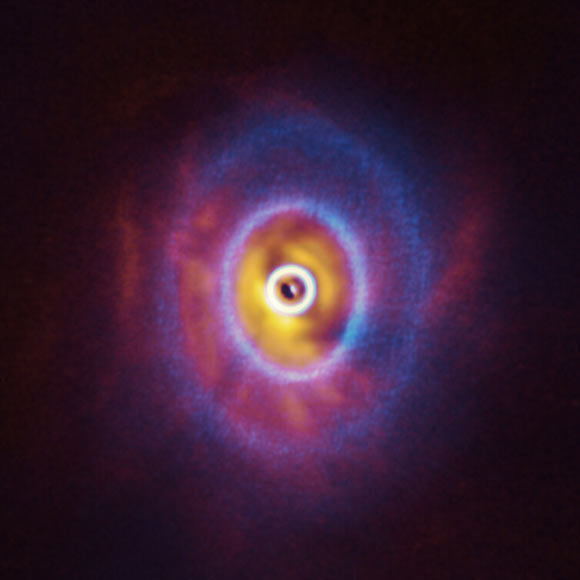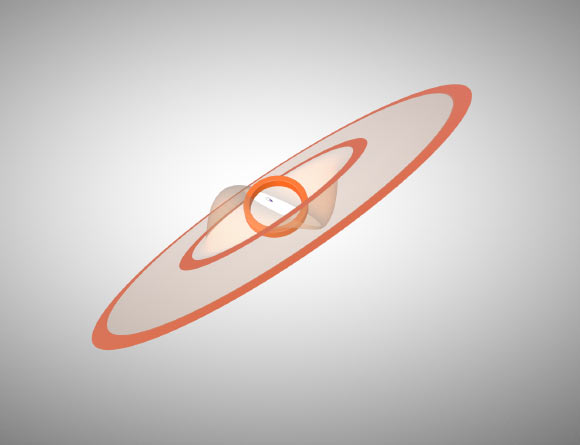Astronomers using the Atacama Large Millimeter/submillimeter Array (ALMA) and the SPHERE (Spectro-Polarimetric High-contrast Exoplanet Research) instrument on ESO’s Very Large Telescope (VLT) have discovered a rare circumtriple protoplanetary disk with misaligned dust rings around the young hierarchical triple system GW Orionis. They give two possible scenarios for the misalignment: either the disk was torn apart by the gravitational pull from the stars, or by a newborn planet.

This composite image shows both ALMA and SPHERE/VLT observations of the disk around GW Orionis. The ALMA image (blue) shows the disk’s ringed structure, with the innermost ring (part of which is visible as an oblong dot at the very center of the image) separated from the rest of the disk. The SPHERE observations (orange-red) allowed the astronomers to see for the first time the shadow of this innermost ring on the rest of the disk, which made it possible for them to reconstruct its warped shape. Image credit: ALMA / ESO / NAOJ / NRAO / ESO / University of Exeter / Kraus et al.
GW Orionis is a triple-star system located approximately 1,312 light-years away in the constellation of Orion.
The two inner stars, GW Orionis A and B, orbit each other and are separated by 1 AU (astronomical units). The third star, GW Orionis C, orbits its two siblings at a distance of roughly 8 AU.
In new research, two independent teams of astronomers pointed ALMA at GW Orionis.
They found three separate rings with different orientations in the massive protoplanetary disk of the triple system, located roughly 46, 185, and 340 AU from its center.
The inner ring is very misaligned relative to both the outer rings and the three stars. The outermost ring is the largest ever observed in protoplanetary disks.
If a planet would be forming in the gap between the inner and outer ring, it would be located incredibly far away from the stars. For comparison, Neptune is only about 30 AU from the Sun.
“We were surprised to see the strong misalignment of the inner ring,” said Jiaqing Bi, an astronomer at the University of Victoria and lead author of a paper published in the Astrophysical Journal Letters.
“But the strange warp in the disk is confirmed by a twisted pattern that ALMA measured in the gas of the disk.”
The second team, led by University of Exeter’s Dr. Stefan Kraus, pointed both ALMA and VLT towards the triple star.
They detected warm gas at the inner edge of the misaligned ring and scattered light from the warped surface of the disk.
“In our images, we see the shadow of the inner ring on the outer disk,” said Dr. Kraus, lead author of a paper published today in the journal Science.
“At the same time, ALMA allowed us to measure the precise shape of the ring that casts the shadow.”
“Combining this information allows us to derive the 3D orientation of the misaligned ring and of the warped disk surface.”

Representation of the disk structure and stellar orbit of GW Orionis, as derived from the ALMA and VLT observations by Kraus et al. Orange rings are the (misaligned) rings seen by ALMA. The transparent surfaces correspond to the lower-density dust filaments that connect the rings and that dominate the emission in scattered light. Image credit: Kraus et al / NRAO / AUI / NSF.
Using telescope arrays operating at infrared wavelengths, the researchers also mapped the orbits of the three stars for over 11 years, covering a full orbital period.
The team found that the three stars do not orbit in the same plane, but that they are misaligned with respect to each other and with respect to the disk.
“This proved crucial to understand how the stars shape the disk,” said Professor John Monnier, an astronomer at the University of Michigan.
Both teams also performed computer simulations to investigate what could possibly cause the inner ring to be misaligned from the rest of the disk and the stars.
Dr. Kraus and colleagues link the observed misalignments to the ‘disk-tearing effect,’ which suggests that the gravitational pull of stars in different planes can warp and break their disks.
Their simulations showed that the misalignment in the orbits of the three stars could cause the disk around them to break into distinct rings.
The simulations by Bi and colleagues hint at another possible explanation for the large misalignment between the inner and middle dust rings.
“Our simulations show that the gravitational pull from the triple stars alone cannot explain the observed large misalignment,” said Dr. Nienke van der Marel, an astronomer at the University of Victoria.
“We think that the presence of a planet between these rings is needed to explain why the disk was torn apart.”
“This planet has likely carved a dust gap and broken the disk at the location of the current inner and outer rings.”
“The inner ring contains enough dust to build 30 Earths, which is sufficient for a planet to form in the ring,” Dr. Kraus said.
“If future studies find this exotic planet — whether it already exists or is still forming — it would be the first planet ever observed to orbit three stars, and it would possess a very unusual orbit.”
_____
Jiaqing Bi et al. 2020. GW Ori: Interactions between a Triple-star System and Its Circumtriple Disk in Action. ApJL 895, L18; doi: 10.3847/2041-8213/ab8eb4
S. Kraus et al. 2020. A triple star system with a misaligned and warped circumstellar disk shaped by disk tearing. Science 369 (6508): 1233-1238; doi: 10.1126/science.aba4633




![The image shows NGC 1866 superimposed with a false color image from the MUSE data cube, where the ionized shell of the planetary nebula Ka LMC 1 is seen as a red ring. The grayscale insets illustrate the different size of the ionized shells of singly ionized nitrogen [N II] and doubly ionized oxygen [O III]. The magnified Hubble image near the center of the ring reveals the presence of a pale blue star -- most probably the hot central star of Ka LMC 1. Image credit: AIP / M.M. Roth / NASA / ESA / Hubble.](https://cdn.sci.news/images/2025/11/image_14348-Ka-LMC-1-104x75.jpg)


